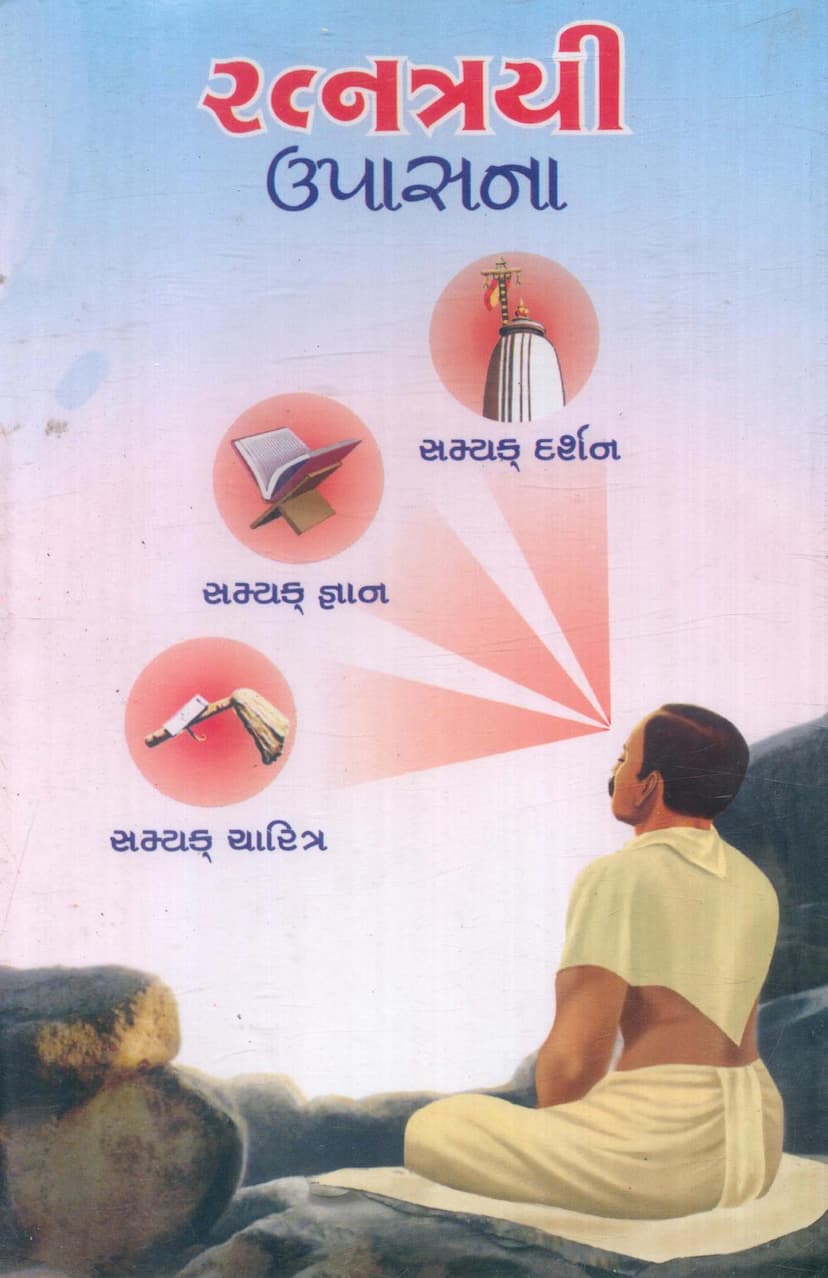Ratnatrayi Upasna
Added to library: September 2, 2025

Summary
The provided text is a Jain scripture titled "Ratnatrayi Upasna" (The Worship of the Three Jewels), compiled and published by the Kakaldas Hirachand Ajbani family. It focuses on the concept of Ratnatrayi, which are the three essential principles of Jainism: Samyak Darshan (Right Faith), Samyak Gyan (Right Knowledge), and Samyak Charitra (Right Conduct).
Here's a breakdown of the comprehensive summary based on the provided pages:
Core Concept: Ratnatrayi (The Three Jewels)
- Samyak Darshan (Right Faith): This is explained as having profound reverence, respect, and faith towards the Dev (God/Arhants), Guru (Saints/Acharaya), Dharma (Jain teachings), and Tattva (Essence/Principles of Jainism). It's an unwavering and pure state of faith.
- Samyak Gyan (Right Knowledge): This involves having a clear and accurate understanding of the Tattvas (soul, non-soul, karmas, etc.), their origins, their nature, and the path to liberation. It is detailed as understanding the distinctions between different principles.
- Samyak Charitra (Right Conduct): This is the practice and adherence to the principles of Right Faith and Right Knowledge through actions, speech, and thought. It encompasses the vows (Mahavratas), the restraints, the disciplines, and the overall virtuous conduct that leads to the purification of the soul.
The Divine Path and Liberation:
The text emphasizes that the path prescribed by the omniscient Tirthankaras is the only means for souls drowning in the vast ocean of the world to reach the shore of salvation. It is described as the sole refuge for the world caught in the cycle of birth, decay, death, sorrow, and grief. This path, in the form of Ratnatrayi, is the ultimate tool for achieving the highest state of liberation (Moksha), which is located on the Siddhshila (the abode of liberated souls).
The Importance of Ratnatrayi:
The text repeatedly highlights the invaluable and rare nature of the Three Jewels (Ratnatrayi). They are considered like the divine Chintamani gem, and it is the union of these three that the wise call the "Ratnatrayi." All forms of worship and practice in Jainism are ultimately directed towards the attainment and adoration of these Three Jewels. The book aims to provide a clear understanding and guidance for the worship (Upasana) of this Ratnatrayi.
Structure and Content:
The book is a compilation of various Jain practices, prayers, and teachings. Based on the provided pages, the content includes:
- Invocation and Salutations: Pages include prayers and salutations to the Panch Paramesthi (the five supreme beings: Arihant, Siddha, Acharya, Upadhyaya, Sadhu), Siddha-chakra, and specific Tirthankaras like Shantinath.
- Mantra Recitation: Mentions of the Panch Paramesthi mantra ("Namo Arihantanam..." etc.) and their significance.
- Worship and Rituals: The text details the process of various pujas (worships), including the Shanti Snatra Mahapujan (a ritual for peace), and mentions the items required for different pujas (pages 230-233). It also covers the meticulous steps involved in daily rituals like getting up, prayer, and sleeping.
- The Panch Sutra: Several pages are dedicated to explaining the meaning and recitation of five key Jain sutras (scriptural passages), likely focusing on core principles and mantras.
- The Navkaravali (Namokar Mantra): Explains the recitation method and benefits of the Namokar Mantra.
- The 24 Tirthankaras: A significant portion of the book is dedicated to the detailed descriptions and prayers for each of the 24 Tirthankaras (pages 16-74, and extensively from page 37 onwards). Each Tirthankara is often associated with specific mantras and descriptions, implying a devotional aspect. The detailed listing of Tirthankaras and their associated worship suggests a focus on devotional practices.
- Bhaktamar Stotra: A significant portion (pages 86-119) is dedicated to the famous Bhaktamar Stotra, detailing its origin, composition, the significance of its meter (Vasanttilaka), and the benefits of reciting its verses. This suggests a strong emphasis on devotional hymns and mantras.
- Detailed Ritual Guidance: Pages 198-227 provide extensive instructions on how to perform various Jain rituals like "Saach Keriye Pratikraman" (Proper Repentance Rituals), explaining the steps, rules, and significance of each action. This includes guidance on Samayika (meditation), Vandan (bowing), and the meaning behind the order of recitations.
- The Significance of Various Rituals: The text seems to cover various aspects of Jain spiritual practice, including daily routines, specific observances, and the underlying philosophy. It highlights the importance of purity, discipline, and mindfulness in these practices.
- Inspirational Stories and Teachings: The book incorporates stories and explanations, such as the origin of the Bhaktamar Stotra, and the importance of various virtues.
- Visual Elements: The inclusion of images of temples, Tirthankaras, and diagrams like the Siddha-chakra Yantra and Rishi-mandala Yantra suggests it is also a visually rich guide.
- Publisher's Note: The publisher's note on page 6 emphasizes the importance of respecting the scriptures, not damaging them, and the family's dedication to promoting the worship of Ratnatrayi.
- Gratitude: The text expresses gratitude to various scholars, elders, and institutions for their guidance and permission to use certain content.
Overall Purpose:
The "Ratnatrayi Upasna" appears to be a comprehensive guide for Jain followers, particularly those seeking to deepen their understanding and practice of the core principles of Jainism. It combines doctrinal explanations with practical rituals, devotional hymns (stotras), and guidelines for daily spiritual life. The extensive coverage of Tirthankaras and their worship, along with the detailed ritualistic instructions, suggests a focus on devotional worship as a means to attain the Ratnatrayi and, ultimately, liberation.